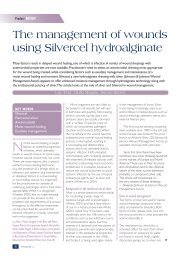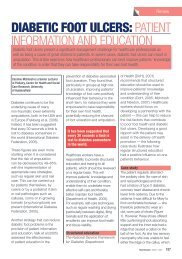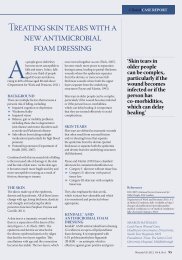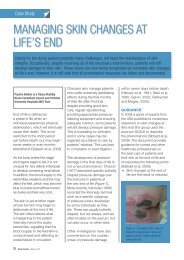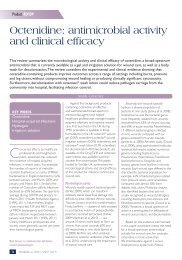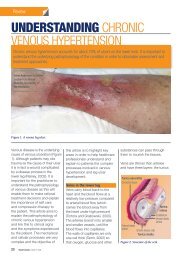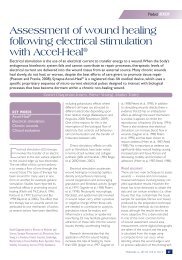VIEW PDF - Wounds UK
VIEW PDF - Wounds UK
VIEW PDF - Wounds UK
Create successful ePaper yourself
Turn your PDF publications into a flip-book with our unique Google optimized e-Paper software.
Product Clinical PRACTICE RE<strong>VIEW</strong> DEVELOPMENT<br />
An evaluation of Versiva ® XC ®<br />
gelling foam dressing and its effect<br />
on wound-related quality of life<br />
The selection of an inappropriate dressing regimen can result in moderate to heavily exuding wounds<br />
having a negative impact upon the patient’s skin and quality of life. However, before integrating a new<br />
dressing into a wound formulary, the clinician responsible must ascertain the product’s quality and costeffectiveness<br />
through appropriate research. This article features a 50-patient evaluation of Versiva ® XC ®<br />
gelling foam dressing, which combines a foam construction with Hydrofiber ® technology in a thin easy-touse<br />
dressing, and its effect on wound-related quality of life in patients with wounds of differing aetiology.<br />
Pauline Beldon, David Gray. Pam Cooper, Simon Barrett<br />
KEY WORDS<br />
Wound care<br />
Quality of life<br />
Exudate<br />
Cost-effectiveness<br />
Wound dressings<br />
The process of evaluating a<br />
wound dressing before its<br />
inclusion in a wound formulary<br />
is familiar to many tissue viability/<br />
wound specialist nurses, pharmacists<br />
and procurement officers. However,<br />
there is a dearth of evidence<br />
to support the use of products<br />
(Vermeulen, 2005).<br />
Pauline Beldon is Nurse Consultant in Tissue Viability,<br />
Epsom and St Helier NHS Hospitals Trust; David Gray<br />
and Pam Cooper are Clinical Nurse Specialists at<br />
the Department of Tissue Viability, NHS Grampian,<br />
Aberdeen; Simon Barrett is a Tissue Viability Nurse<br />
Specialist, Hull Primary Care Trust<br />
When it comes to the provision of<br />
evidence, randomised controlled trials<br />
(RCTs) are seen as the gold standard.<br />
However, RCTs limit the types of<br />
wound aetiologies and patient groups<br />
that can be studied and can therefore<br />
provide a narrow view of a dressing’s<br />
performance.<br />
Examination of a broad cohort<br />
of patients with several wound<br />
An improved quality of<br />
life, for example, having a<br />
wound dressing that does<br />
not stain clothing, is often<br />
greatly appreciated by<br />
patients.<br />
aetiologies can provide a much more<br />
comprehensive view and reduce the<br />
work of the specialist when it comes to<br />
choosing an appropriate dressing.<br />
This article details an evaluation<br />
of Versiva ® XC ® gelling foam dressing<br />
(ConvaTec), which was trialed on a<br />
cohort of 50 patients with a variety of<br />
wound aetiologies. It provides evidence<br />
of the dressing’s effect on pain and<br />
odour from the patient’s perspective<br />
as well as examining its fluid-handling<br />
capability, frequency of change required,<br />
conformability and ease of application<br />
of the dressings from the clinician’s<br />
point of view.<br />
Moderate to highly exuding wounds<br />
continue to provide a huge challenge<br />
to the skill of the managing clinician<br />
and the impact of an exuding wound<br />
upon the patient’s quality of life is well<br />
documented (Harding et al, 2000).<br />
Clinicians should remember that<br />
wound healing may not be the primary<br />
aim of care, especially from the<br />
patient’s point of view. An improved<br />
quality of life, for example, having a<br />
wound dressing that does not stain<br />
clothing, is often greatly appreciated by<br />
patients.<br />
Evidence<br />
Before integrating any dressing into<br />
a wound formulary, the clinician<br />
responsible, be it a tissue viability<br />
nurse (TVN), wound specialist,<br />
pharmacist or procurement officer,<br />
must decide on the product’s quality<br />
and cost-effectiveness by reviewing the<br />
available evidence.<br />
Wound dressings are expensive<br />
and all clinicians are subject to budget<br />
constraints, indeed an integral part of<br />
any clinician’s role involves allocating<br />
resources wisely to provide quality<br />
healthcare — this applies to wound<br />
management as much as any other<br />
specialty.<br />
The National Institute of Health<br />
and Clinical Excellence (NICE)<br />
provides evidence on treatments,<br />
76<br />
<strong>Wounds</strong> uk, 2010, Vol 6, No 1
® / TM indicates trademarks of ConvaTec Inc. © 2009 ConvaTec Inc. AP-007927-MM<br />
products and medicines to guide<br />
clinicians’ practice. It utilises the qualityadjusted<br />
life years measurement (QALY),<br />
a measurement of disease burden, which<br />
uses factors such as pain levels, mobility<br />
and mood, to calculate how many years<br />
a product would add to a patient’s life<br />
and thereby its cost-effectiveness, i.e.<br />
how much does one wound dressing<br />
cost per QALY (NICE, 2008).<br />
The QALY method takes into<br />
account that the cost of a wound<br />
dressing includes not only the retail<br />
price, but also the nursing time involved<br />
— a valuable commodity and one that<br />
is insufficiently recognised (Harding<br />
et al, 2000). The QALY method can<br />
help clinicians avoid, for example using<br />
inexpensive dressings, which manage<br />
exudate poorly and require changing<br />
on a daily basis, over more expensive<br />
products, which manage wound exudate<br />
well and only require changing twice<br />
weekly.<br />
In addition to examining the<br />
quality and cost-effectiveness of each<br />
wound dressing, a clinician should also<br />
investigate the evidence to determine<br />
whether or not the product achieves the<br />
manufacturer’s claims. Much is made of<br />
the lack of evidence available to support<br />
wound dressings, especially in the form<br />
of RCTs. However, it could be argued<br />
that RCTs provide very little in the form<br />
of useable information for the clinician<br />
who has to manage chronic wounds<br />
(unless specific wound aetiology is under<br />
investigation) as these wound types are<br />
often excluded from RCTs (Timmons,<br />
2008).<br />
The difficulty of recruiting patients<br />
with wounds of a similar size and with<br />
similar co-morbidities onto an RCT<br />
is immense. Also, vascular supply and<br />
nutritional status play a significant role<br />
in wound healing; however, locating<br />
a significant number of patients with<br />
similar vascular and nutritional status<br />
could take years.<br />
Professor Rawlins (2008), Chair of<br />
NICE, recently stated that: ‘Hierarchies<br />
of evidence should be replaced by<br />
accepting — indeed embracing — a<br />
diversity of approaches. This is not a<br />
Discover<br />
what happens when you apply<br />
Versiva ® XC ® dressing<br />
Versiva ® XC ® dressing. Expect more…<br />
Find out more about Versiva ® XC ® dressing and arrange a visit from your<br />
ConvaTec representative:<br />
www.convatec.com/versivaxc<br />
<strong>Wounds</strong> uk, 2010, Vol 6, No 1<br />
Realise the possibilities
Product Clinical PRACTICE RE<strong>VIEW</strong> DEVELOPMENT<br />
Patient’s date of birth<br />
Figure 1. The evaluation form.<br />
Wound details<br />
Gender M / F Wound size<br />
Medical history<br />
Cardiac<br />
COPD<br />
Diabetes type 1<br />
Diabetes type 2<br />
Rheumatoid<br />
Other conditions<br />
Allergies<br />
Treatment history<br />
Previous primary dressing<br />
Previous secondary dressing<br />
Frequency of dressing change<br />
Versiva ® XC ® performance<br />
Size of product used<br />
Time taken to apply (minutes)<br />
Ease of application<br />
Wound site<br />
Length (cm)<br />
Breadth (cm)<br />
Depth (cm)<br />
Volume (if known)<br />
Wound assessment<br />
Healing continuum<br />
Infection continuum<br />
Exudate continuum<br />
Investigations:<br />
Ankle brachial pressure index<br />
Haemoglobin<br />
Temperature<br />
White cell count<br />
Wound swab<br />
Other dressings used in combination<br />
On removal of Versiva ® XC ®<br />
was the patient’s skin affected<br />
Did patient experience pain Skin stripping Y / N<br />
During dressing application Y / N Reactive hyperaemia Y / N<br />
Once the dressing was applied Y / N Rash Y / N<br />
During dressing removal Y / N Maceration Y / N<br />
Did the dressing conform to the wound<br />
Y / N<br />
Was odour present<br />
Did the dressing leak before dressing change occurred Y / N Dressing odour Y / N<br />
Wound odour<br />
Y / N<br />
Did the wound change while being treated with Versiva ® XC ® <br />
Better<br />
Y / N<br />
Same<br />
Y / N<br />
Worse<br />
Y / N<br />
plea to abandon RCTs and replace them<br />
with observational studies ... it is a plea<br />
to investigators to continue to develop<br />
and improve their methodologies.’<br />
Clinicians and researchers should<br />
work together to examine when RCTs<br />
78 <strong>Wounds</strong> uk, 2010, Vol 6, No 1<br />
are appropriate and when other forms<br />
of investigation, such as the systematic<br />
review of case reports, could highlight<br />
other areas of care.<br />
Versiva ® XC ® gelling foam dressing<br />
Versiva ® XC ® gelling foam dressing<br />
combines foam product construction<br />
with Hydrofiber ® technology (which<br />
many healthcare professionals<br />
are familiar with in the form of<br />
AQUACEL ® [ConvaTec]) in a thin,<br />
easy-to-use dressing. Unlike some<br />
traditional foam dressings, which
® / TM indicates trademarks of ConvaTec Inc. © 2009 ConvaTec Inc. AP-007927-MM<br />
absorb fluid into the air pockets of the<br />
foam structure, Hydrofiber ® technology<br />
absorbs fluid into the interior of the<br />
fibres, causing them to swell and merge<br />
with each other to form a cohesive gel.<br />
This gelling action is specific to the area<br />
where fluid is absorbed — where there<br />
is no fluid, the fibres remain dry.<br />
Because fluid is absorbed and<br />
retained within the fibres rather than<br />
just being taken into air gaps or pockets<br />
between fibres or inside a foam,<br />
the fluid is effectively retained when<br />
pressure is applied.<br />
Versiva ® XC ® gelling foam dressings<br />
are available in both adhesive and nonadhesive<br />
formats and come in square,<br />
heel and sacral shapes.<br />
Versiva ® XC ® gelling foam dressing<br />
is indicated for moderate to heavily<br />
exuding acute or chronic wounds.<br />
The evaluation<br />
The authors of this evaluation<br />
observed the wounds of 50 patients<br />
aged between 52–100 years using a<br />
systematic evaluation to determine the<br />
effectiveness of Versiva ® XC ® gelling<br />
foam dressing in dealing with some<br />
specific quality of life factors including:<br />
8 Wound aetiology<br />
8 Dressing frequency<br />
8 Conformability and ease<br />
of application<br />
8 Patient comfort<br />
8 Adverse reactions<br />
8 Perception of odour<br />
8 The dressing’s use in diabetic<br />
patients<br />
8 Healing continuum.<br />
The patients’ wound aetiologies<br />
included pressure ulcers, leg ulcers,<br />
traumatic injuries and complex surgical<br />
wounds. Patients with diabetes were<br />
not excluded (as is often the case with<br />
RCTs that do not have diabetic patients<br />
as their focus), as the authors felt it vital<br />
that a wound dressing should be able<br />
to demonstrate its effectiveness upon<br />
a range of wound aetiologies, including<br />
the most challenging.<br />
Similarly, a range of wound sites<br />
were included in order to test the<br />
Versiva ® XC ® dressing<br />
transforms wounds<br />
Thanks to its gelling Hydrofiber ® Technology, exudate is absorbed<br />
and locked in, 1 trapping harmful bacteria 2,3 and enzymes, 4 creating<br />
an optimal moist wound environment that kick-starts healing. 5 *<br />
Versiva ® XC ® dressing. Expect more…<br />
Find out more about Versiva ® XC ® dressing and arrange a visit from your<br />
ConvaTec representative:<br />
www.convatec.com/versivaxc<br />
Realise the possibilities <br />
*As demonstrated in vitro<br />
1. Waring MJ, Parsons D. Physico-chemical characterisation of carboxymethylated spun cellulose fibres. Biomaterials. 2001;22:903-912.<br />
2. Walker M, Hobot JA, Newman GR, Bowler PG. Scanning electron microscopic examination of bacterial immobilisation in a<br />
carboxymethylcellulose (Aquacel) and alginate dressings. Biomaterials. 2003;24(5):883-890. 3. Newman GR, Walker M, Hobot J,<br />
Bowler P. Visualisation of bacterial sequestration and bactericidal activity within hydrating Hydrofiber ® wound dressings. Biomaterials.<br />
2006;27:1129-1139. 4. Walker M, Bowler PG, Cochrane <strong>Wounds</strong> CA. In vitro uk, studies 2010, to show sequestration Vol 6, of No matrix 1metalloproteinases by silvercontaining<br />
wound care products. Ostomy Wound Manage. 2007;53(9):18-25. 5. Vanscheidt W, Münter KC, Klövekorn W, Vin F, Gauthier JP,<br />
Ukat A. A prospective study on the use of a non-adhesive gelling foam dressing on exuding leg ulcers. J Wound Care. 2007;16(6):261-265.
Clinical PRACTICE DEVELOPMENT<br />
8%<br />
18%<br />
Complex<br />
Leg ulcer<br />
Pressure ulcer<br />
Surgical<br />
Trauma<br />
10%<br />
44%<br />
20%<br />
Dressings changes per week<br />
12<br />
10<br />
8<br />
6<br />
4<br />
2<br />
Pre application<br />
Post application<br />
0<br />
1 5 9 13 17 21 25 29 33 37 41 45<br />
Patients<br />
Figure 4. Frequency of dressing changes pre and post use of Versiva ® XC ® gelling foam dressing.<br />
Figure 2. Aetiologies of the wounds in the study.<br />
38%<br />
High<br />
Moderate<br />
Minimal<br />
Figure 3. Volume of exudate.<br />
18%<br />
44%<br />
conformability of the wound dressing,<br />
since any dressing that does not<br />
demonstrate conformability can restrict<br />
clinicians’ options in practice.<br />
The patients were drawn from<br />
both primary and secondary healthcare<br />
settings across three different sites:<br />
8 Hospitals in Aberdeen<br />
8 Community settings in Hull<br />
8 Hospitals in Epsom and<br />
Carshalton.<br />
The patients were selected by the<br />
clinicians, on the basis that they had a<br />
80 <strong>Wounds</strong> uk, 2010, Vol 6, No 1<br />
wound, which was producing exudate.<br />
The patients were then assessed and<br />
treated by the clinicians and nursing<br />
staff within the hospital setting or in<br />
the community. Evaluation forms were<br />
completed on a secure electronic<br />
database after each wound review.<br />
The clinicians involved in this audit<br />
were provided with the full range of<br />
Versiva ® XC ® dressings, including the<br />
adhesive, non-adhesive, square, heel<br />
and sacral-shape versions.<br />
On completion of the study the<br />
clinicians met to discuss the results and<br />
systematically review each patient in<br />
order to identify if any patterns arose,<br />
e.g. whether the dressing performed<br />
when used on moist or heavily exuding<br />
wounds. They also discussed whether<br />
there were any difficulties with the<br />
dressings, i.e. were they conformable<br />
to the wound area<br />
Evaluation form<br />
Performing an extensive evaluation<br />
of a wound dressing can provide vital<br />
information. However, it is vital that<br />
any evaluation is not only acceptable<br />
for patients with regard to pain<br />
management and exudate control, but<br />
also uncomplicated for clinicians<br />
to apply.<br />
The evaluation form used in<br />
this evaluation (Figure 1), helped<br />
investigators to focus on factors<br />
important for both patient and<br />
clinician.<br />
Results<br />
Wound aetiology<br />
A number of patients with different<br />
wound aetiologies and with both acute<br />
and chronic wounds were evaluated<br />
(Figure 2). Traumatic injuries included<br />
skin tears and lacerations — injuries<br />
common in older people due to the<br />
fragility of ageing skin.<br />
Leg ulcers of all aetiologies were<br />
included as the dressing was evaluated<br />
for exudate management, comfort<br />
and conformability, all of which can be<br />
difficult to manage in lower leg ulcers.<br />
In order to observe whether the<br />
wound bed continued to progress and<br />
whether dressing change frequency<br />
could be reduced, which would<br />
result in time savings for clinicians<br />
and reduced dressing changes for<br />
the patient, wounds were included<br />
regardless of the volume of exudate<br />
being produced. Figure 3 demonstrates<br />
the volumes of exudate produced by<br />
the wounds in the evaluation:<br />
8 High volumes of exudate: nine<br />
wounds (18%)<br />
8 Moderate volumes of exudate: 22<br />
wounds (44%)<br />
8 Minimal volumes of exudate: 19<br />
wounds (38%).
® / TM indicates trademarks of ConvaTec Inc. © 2009 ConvaTec Inc. AP-007927-MM<br />
Dressing frequency<br />
Figure 4 demonstrates that there were<br />
significant reductions in the change of<br />
dressing frequency in the majority of<br />
patients observed.<br />
Conformability and ease of application of dressing<br />
The dressing shapes predominantly<br />
used in this evaluation were the<br />
adhesive square Versiva ® XC ® gelling<br />
foam dressings (Figure 5). These were<br />
occasionally used in areas of the<br />
body that would not be immediately<br />
obvious, i.e. the sacral area in patients<br />
for whom the sacral dressing did not<br />
conform, however, the investigators<br />
assessed that these dressing shapes<br />
were the most appropriate for the<br />
individual wound involved.<br />
The majority of investigators<br />
found the Versiva ® XC ® gelling foam<br />
dressings ‘very easy’ to apply (Figure<br />
6), however, with two patients the<br />
investigators found it ‘difficult’ to apply<br />
the adhesive heel dressings and on<br />
five occasions investigators found it<br />
‘difficult’ to apply the adhesive square<br />
dressings. None of the investigators<br />
found the Versiva ® XC ® gelling foam<br />
dressings ‘very difficult’ to apply.<br />
The majority (76%) of investigators<br />
found the Versiva ® XC ® gelling foam<br />
dressings conformable to the wound<br />
and peri-wound area (Figure 7).<br />
Patient comfort<br />
Patients were asked whether they<br />
experienced any pain or discomfort<br />
on application, removal or while<br />
wearing the Versiva ® XC ® gelling<br />
foam dressings (Figure 8). The vast<br />
majority did not experience any<br />
pain or discomfort, although six<br />
patients (12%) did complain of<br />
pain on either application, removal<br />
or during wear. However, only one<br />
patient complained of pain both<br />
while wearing the dressing and on<br />
its removal — all other patients<br />
complained of pain only once, either<br />
on application or during wear/<br />
removal of the dressing.<br />
Adverse reactions<br />
Figure 9 illustrates that six patients<br />
(12%) experienced both leakage of<br />
Versiva ® XC ® dressing<br />
transforms wounds<br />
It’s only a small change for caregivers, but because Hydrofiber ®<br />
Technology creates an optimal moist wound healing environment, 1<br />
you really can expect more from Versiva ® XC ® dressing.<br />
Now you’ve discovered<br />
Versiva ® XC ® dressing… try it.<br />
Versiva ® XC ® dressing. Expect more…<br />
Find out more about Versiva ® XC ® dressing and arrange a visit from your<br />
ConvaTec representative:<br />
www.convatec.com/versivaxc<br />
Realise the possibilities <br />
<strong>Wounds</strong> uk, 2010, Vol 6, No 1<br />
*As demonstrated in vitro<br />
1. Vanscheidt W, Münter KC, Klövekorn W, Vin F, Gauthier JP, Ukat A. A prospective study on the use of a non-adhesive gelling foam dressing<br />
on exuding leg ulcers. J Wound Care. 2007;16(6):261-265.
Product Clinical PRACTICE RE<strong>VIEW</strong> DEVELOPMENT<br />
8%<br />
8%<br />
17%<br />
24%<br />
22%<br />
62%<br />
21%<br />
62%<br />
76%<br />
Adhesive Square<br />
Non-Adhesive Square<br />
Adhesive Heel<br />
Adhesive Sacral<br />
Figure 5. Types of Versiva ® XC ® gelling foam<br />
dressing evaluated.<br />
Very easy<br />
Easy<br />
Difficult<br />
Very difficult<br />
Figure 6. Ease of application.<br />
Yes<br />
No<br />
Figure 7. Conformability to the wound area.<br />
exudate and skin maceration while<br />
wearing the Versiva ® XC ® gelling<br />
foam dressing. This could be due to<br />
clinicians’ unrealistic expectations of<br />
the dressing as despite these patients’<br />
wounds being assessed as producing<br />
high volumes of exudate, no absorbent<br />
primary dressing was applied, which<br />
may have been beneficial (Cooper et<br />
al, 2009). Only one patientexperienced<br />
an apparent skin reaction due to<br />
sensitivity.<br />
Perception of odour<br />
During the evaluation, 12 patients<br />
perceived an odour emanating from<br />
their wound — six of these felt there<br />
was an odour emanating from the<br />
dressing (Figure 10).<br />
Number of patients<br />
50<br />
40<br />
30<br />
20<br />
10<br />
0<br />
Yes<br />
No<br />
Patients with diabetes<br />
Six patients with diabetes were<br />
included in the evaluation and their<br />
wounds either improved or remained<br />
the same (Figure 11).<br />
Wound healing continuum<br />
Wound healing was not the primary<br />
aim of the evaluation, however where<br />
possible wound volume was measured<br />
in order for both clinicians and<br />
patients to determine whether using<br />
Versiva ® XC ® gelling foam dressing<br />
had a positive effect on healing (Figure<br />
12). Fourteen patients’ wounds (28%)<br />
decreased in size, 19 (38%) remained<br />
unchanged, seven (14%) were lost to<br />
follow-up and three (6%) appeared<br />
to worsen.<br />
Pain on application Pain during dressing wear Pain on removal<br />
Discussion<br />
One of the difficulties highlighted in<br />
this evaluation was a lack of training<br />
for some clinicians in using the<br />
dressing. Not including training for all<br />
of the clinicians may have resulted in<br />
some of the problems encountered<br />
with application of the dressing,<br />
unrealistic expectation of wear<br />
time and the absence of a primary<br />
absorbent dressing (Cooper et al,<br />
2009).<br />
Patients have differing body shapes<br />
and dressing evaluations should include<br />
a section where investigators can<br />
record such information, for example<br />
an obese or cachectic patient will test<br />
a dressing’s ability to conform, both<br />
to the wound itself and the patient’s<br />
body shape. In this evaluation, 76%<br />
of clinicians found the Versiva ® XC ®<br />
gelling foam dressing conformable<br />
— the same percentage found the<br />
dressings either ‘very easy’ or ‘easy’<br />
to apply.<br />
However, 14% of clinicians found<br />
the dressings did not conform well to<br />
the patient’s body and a further 14%<br />
reported that the Versiva ® XC ® gelling<br />
foam dressings were ‘difficult’ to apply,<br />
highlighting again the training issues<br />
vital for a comprehensive evaluation.<br />
Figure 8. Patient’s pain experience.<br />
Six patients (12%) experienced<br />
82 <strong>Wounds</strong> uk, 2010, Vol 6, No 1
Clinical PRACTICE Product DEVELOPMENT RE<strong>VIEW</strong><br />
Number of patients<br />
Yes No<br />
60<br />
50<br />
40<br />
30<br />
20<br />
10<br />
0<br />
Maceration Leakage Skin reaction<br />
Figure 9. Adverse skin reactions.<br />
an odour, with six [12%] of these<br />
believing the odour was coming from<br />
the dressing rather than the wound.<br />
This is an unfortunate result as<br />
patients are naturally self-conscious<br />
about any perceived or real odour.<br />
While the vast majority of<br />
patients (44) did not experience any<br />
pain or discomfort when using the<br />
Versiva ® XC ® gelling foam dressing,<br />
two patients (4%) reported pain on<br />
application, three (6%) complained of<br />
discomfort on wearing the dressing<br />
and two (4%) reported discomfort<br />
on removal.<br />
Number of patients<br />
50<br />
45<br />
40<br />
35<br />
30<br />
25<br />
20<br />
15<br />
10<br />
5<br />
0<br />
Yes<br />
No<br />
Figure 10. Perception of odour.<br />
Improved<br />
Same<br />
Deteriorated<br />
Dressing odour<br />
50% 50%<br />
Figure 11. Status of diabetic wounds following use<br />
of Versiva ® XC ® gelling foam dressing.<br />
Wound odour<br />
both leakage of exudate and<br />
maceration of their peri-wound skin.<br />
These patients all had high levels of<br />
exudate indicating that the dressing<br />
was not replaced promptly when<br />
saturated. This would appear to be a<br />
training issue as all six patients were<br />
recruited by the same clinician. It is<br />
vital that the appropriate size dressing<br />
is used and also that it is changed<br />
when indicated, i.e. when saturated<br />
with exudate — if a saturated dressing<br />
is left in situ this can lead to skin<br />
maceration.<br />
One patient (2%) experienced an<br />
apparent skin reaction to the border<br />
of the Versiva ® XC ® gelling foam<br />
Adhesive dressing.<br />
Twelve patients (24%) perceived<br />
However, on closer inspection<br />
of the evaluation forms it transpired<br />
that only one patient complained of<br />
pain on more than one occasion and<br />
that most of the patients complained<br />
of pain on either application, wear<br />
or removal, but not all three. This<br />
suggests that either the patient’s pain<br />
management fluctuated (either due<br />
to their own self-assessment of pain<br />
or due to timing of analgesia) or the<br />
pain was caused by the investigator’s<br />
inexperience in using the dressings.<br />
Patients complaining of pain were<br />
all attended by district nurses who<br />
found the dressings non-conformable<br />
and experienced difficulty in<br />
application. This reinforces the need to<br />
collaborate with the manufacturer to<br />
ensure appropriate training is provided<br />
before using any new product.<br />
Six patients (12%) with diabetes<br />
were included in the evaluation and<br />
their wounds either improved or<br />
remained the same. In addition, the<br />
Versiva ® XC ® gelling foam dressings<br />
were found to be conformable, an<br />
attribute vital in managing diabetic<br />
wounds. Bulky or creased dressings can<br />
apply pressure to the diabetic wound<br />
area and lead to deterioration.<br />
During the evaluation, 14 patients’<br />
wounds (28%) decreased in size, 19<br />
(38%) remained unchanged, seven<br />
patients (14%) were lost to follow-up<br />
and three wounds (6%) appeared to<br />
worsen. This deterioration was due<br />
either to the wound increasing in size<br />
<strong>Wounds</strong> uk, 2010, Vol 6, No 1<br />
83
Clinical PRACTICE DEVELOPMENT<br />
2000<br />
Pre application<br />
Post application<br />
Key points<br />
Volume in cm<br />
1500<br />
1000<br />
500<br />
0<br />
1 5 9 13 17 21 25 29 33 37 41 45<br />
Patients<br />
8 Exuding wounds can be<br />
difficult to manage.<br />
8 Evaluation of a wound<br />
dressing should also consider<br />
the patient’s experience of the<br />
dressing.<br />
8 Prior to evaluation of<br />
a wound dressing, all<br />
participating staff should be<br />
fully trained in how to use<br />
the dressing.<br />
Figure 12. Wound volume pre and post application of Versiva ® XC ® gelling foam dressing.<br />
after debridement or deterioration in<br />
the patient’s condition rather than any<br />
problem with the Versiva ® XC ® gelling<br />
foam dressings (as evidenced by the<br />
clinicians’ documentation).<br />
Although there were instances<br />
when wounds appeared to deteriorate<br />
due to exudate leakage and the<br />
associated maceration, it is possible<br />
that clinicians did not change the<br />
dressings with sufficient frequency or<br />
had unrealistic expectations of the<br />
dressing’s fluid handling capability.<br />
Conclusion<br />
This evaluation has provided some<br />
valuable information about the<br />
Versiva ® XC ® gelling foam dressing,<br />
which will enable clinicians to<br />
determine whether or not it will be of<br />
use in their practice.<br />
The range of patients and wounds<br />
included in this evaluation will be<br />
familiar to most TVNs and will help<br />
them decide whether to include the<br />
dressing in their wound formularies.<br />
This is in contrast to an RCT, which<br />
would take far longer to achieve,<br />
would be limited to perhaps one<br />
wound aetiology and where the<br />
presence of comorbidities might<br />
exclude the very patient group in<br />
whom clinicians are most interested.<br />
This evaluation has highlighted very<br />
clearly that before any wound dressing<br />
evaluation any clinicians inexperienced<br />
in using the dressing should undergo<br />
a period of training to ensure the<br />
product is fairly evaluated and that<br />
no bias is introduced due to lack of<br />
knowledge or experience.<br />
One valuable finding of the<br />
evaluation is the necessity to record<br />
a patient’s body shape and weight as<br />
one investigating team experienced<br />
difficulties in the application of Versiva ®<br />
XC ® gelling foam dressing. While the<br />
problem may have been a training<br />
issue, the problem may equally have<br />
arisen due to an obese or grossly<br />
debilitated patient.<br />
When asked, the vast majority of<br />
patients described Versiva ® XC ® gelling<br />
foam dressing as comfortable and did<br />
not complain of odour. Perhaps more<br />
wound dressing evaluations should<br />
include overall patient satisfaction, with<br />
clinicians considering patients’ opinions<br />
— after all patients may have valid<br />
suggestions about the care of their<br />
wounds.<br />
Since none of the patients in this<br />
evaluation experienced an increase<br />
in dressing change frequency, Versiva ®<br />
XC ® gelling foam dressing clearly has<br />
a good fluid-handling capability and<br />
depending on appropriate training<br />
is likely to prove conformable and<br />
easy for the vast majority of clinicians<br />
to apply. Wuk<br />
8 Evaluating one dressing<br />
through examining its<br />
impact on a large group of<br />
patients can produce valuable<br />
information regarding the<br />
dressing’s efficacy.<br />
Declaration of interest: this article<br />
was prepared with the assistance of<br />
ConvaTec Ltd.<br />
References<br />
Cooper P, Beldon P, Barett S, Russell F,<br />
Gray D (2009) Best Practice Statement:<br />
Optimising the use of Versiva ® XC ® Gelling<br />
Foam Dressing. <strong>Wounds</strong> <strong>UK</strong>, Aberdeen<br />
Harding K, Cutting K, Price P (2000) The<br />
cost-effectiveness of wound management<br />
protocols of care. Br J Nurs 9(19): 6–10<br />
National Institute for Health and Clinical<br />
Excellence (2008) Measuring Effectiveness<br />
and Cost-effectiveness; the QALY. NICE,<br />
London<br />
Rawlins M (2008) De Testimonio: on<br />
the evidence for decisions about the use<br />
of therapeutic interventions. Harveian<br />
Oration of 2008. Available online at: www.<br />
thelancet.com/journals/lancet/article/<br />
PIIS0140-6736(08)61930-3/fulltext<br />
[accessed 24 January, 2010]<br />
Timmons J (2008) The RCT gold standard<br />
may be blinding us to the value of other<br />
research methods. <strong>Wounds</strong> <strong>UK</strong> 4(3): 6<br />
Vermuelen H, Ubbink DT, Goossens A, De<br />
Vos R, Legemate DA (2005) Systematic<br />
review of dressings and topical agents for<br />
surgical wounds healing by secondary<br />
intention. Br J Surg 92(6): 665–72<br />
84 <strong>Wounds</strong> uk, 2010, Vol 6, No 1



